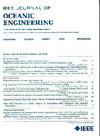Underwater Surface Normal Reconstruction via Cross-Grained Photometric Stereo Transformer
IF 3.8
2区 工程技术
Q1 ENGINEERING, CIVIL
引用次数: 0
Abstract
Modern ocean research necessitates high-precision 3-D underwater data acquisition. Photometric stereo is a critical technique for recovering high-resolution, dense surface normals of textureless objects, such as the seabed and underwater pipelines. This technique is fundamental for underwater robots engaged in ocean exploration and operational tasks. Traditional underwater photometric stereo methods account for distributed underwater media, such as light scattering. However, the deployment of devices in complex underwater environments (e.g., ocean currents) often results in misalignment and jitter among photometric stereo images. These challenges lead to inaccuracies in matching-based methods, particularly due to the lack of texture and varying illumination conditions. To address these issues, we propose the Cross-Grained Transformer Photometric Stereo (CGT-PS) Network. CGT-PS is designed to directly manage misaligned pixels caused by underwater jitter in an end-to-end manner. The proposed method consists of two main components: the local-grained and global-grained modules. The local-grained module utilizes a Shift operation to adjust pixels within a single-pixel span, effectively mitigating misalignment caused by motion without increasing computational cost. In contrast, the global-grained module performs nonlocal fusion learning, leveraging distant features to enhance the extraction of intricate structural details, cast shadows, and interreflection regions. Ablation studies confirm the efficacy of the proposed modules. Extensive experiments on photometric stereo benchmark data sets and real underwater photometric stereo samples demonstrate that our method achieves superior performance.水下表面法向重建的交叉粒度光立体变压器
现代海洋研究需要高精度的水下三维数据采集。光度立体是一项关键技术,用于恢复高分辨率,密集的表面法线的无纹理物体,如海底和水下管道。这项技术是水下机器人从事海洋勘探和操作任务的基础。传统的水下立体测光方法考虑了光散射等水下介质的分布。然而,在复杂的水下环境(如洋流)中部署设备往往会导致光度立体图像之间的错位和抖动。这些挑战导致了基于匹配的方法的不准确性,特别是由于缺乏纹理和不同的照明条件。为了解决这些问题,我们提出了交叉粒度变压器光度立体(CGT-PS)网络。CGT-PS旨在以端到端的方式直接管理由水下抖动引起的不对齐像素。该方法由两个主要组件组成:局部粒度模块和全局粒度模块。局部粒度模块利用Shift操作在单像素范围内调整像素,有效地减轻了运动引起的不对齐,而不会增加计算成本。相比之下,全局粒度模块执行非局部融合学习,利用远程特征来增强复杂结构细节、投射阴影和互反射区域的提取。烧蚀研究证实了所提出模块的有效性。在光度立体基准数据集和真实水下光度立体样本上进行的大量实验表明,该方法具有较好的性能。
本文章由计算机程序翻译,如有差异,请以英文原文为准。
求助全文
约1分钟内获得全文
求助全文
来源期刊

IEEE Journal of Oceanic Engineering
工程技术-工程:大洋
CiteScore
9.60
自引率
12.20%
发文量
86
审稿时长
12 months
期刊介绍:
The IEEE Journal of Oceanic Engineering (ISSN 0364-9059) is the online-only quarterly publication of the IEEE Oceanic Engineering Society (IEEE OES). The scope of the Journal is the field of interest of the IEEE OES, which encompasses all aspects of science, engineering, and technology that address research, development, and operations pertaining to all bodies of water. This includes the creation of new capabilities and technologies from concept design through prototypes, testing, and operational systems to sense, explore, understand, develop, use, and responsibly manage natural resources.
 求助内容:
求助内容: 应助结果提醒方式:
应助结果提醒方式:


